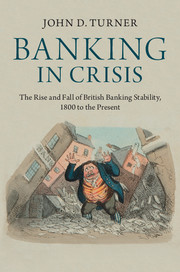Book contents
- Frontmatter
- Contents
- List of figures
- List of tables
- Acknowledgements
- 1 Introduction: Holding shareholders to account
- 2 Banking instability and risk shifting
- 3 The evolution of British banking structure and stability since 1800
- 4 Major and minor British banking crises since 1800
- 5 Banking stability, shareholder liability and bank capital
- 6 Averting or creating banking crises? The lender of last resort and bank rescues
- 7 Banking stability and bank regulation
- 8 Restoring banking stability: Policy and political economy
- Bibliography
- Index
- References
4 - Major and minor British banking crises since 1800
Published online by Cambridge University Press: 05 July 2014
- Frontmatter
- Contents
- List of figures
- List of tables
- Acknowledgements
- 1 Introduction: Holding shareholders to account
- 2 Banking instability and risk shifting
- 3 The evolution of British banking structure and stability since 1800
- 4 Major and minor British banking crises since 1800
- 5 Banking stability, shareholder liability and bank capital
- 6 Averting or creating banking crises? The lender of last resort and bank rescues
- 7 Banking stability and bank regulation
- 8 Restoring banking stability: Policy and political economy
- Bibliography
- Index
- References
Summary
Each separate panic has had its own distinctive features, but all have resembled each other in occurring immediately after a period of prosperity, the hollowness of which it has exposed. So uniform is this sequence, that wherever we find ourselves under circumstances that enable the acquisition of rapid fortunes, otherwise than by plodding industry, we may almost be justified in auguring that the time for panic is at hand.
D. Morier EvansIntroduction
The previous chapter established that there were major banking crises in the United Kingdom in 1825–6 and 2007–8 and that in the interim period, there was a series of what we termed minor crises (i.e., 1836–7, 1847, 1857–8, 1866–7, 1878–9 and 1974). In this chapter, we develop narrative accounts of these major and minor crises. The main reasons for doing so are twofold.
First, we need a qualitative idea of the extent and scale of these crises to confirm (or otherwise) the results from the quantitative measures of stability developed in Chapter 3. In particular, we explore how each crisis developed and analyse anecdotal evidence of its severity. In addition, to understand why they failed, we examine the major institutions that experienced difficulties or failed during each crisis episode.
Second, we want to examine the possible triggers for and precursors to each crisis. Because easy monetary and credit conditions and speculation are important elements of both the Kindleberger and Minsky explanations for crises, we examine monetary and credit conditions in the run-up to each crisis and also consider whether speculation in assets of various types preceded each crisis.
- Type
- Chapter
- Information
- Banking in CrisisThe Rise and Fall of British Banking Stability, 1800 to the Present, pp. 66 - 101Publisher: Cambridge University PressPrint publication year: 2014



